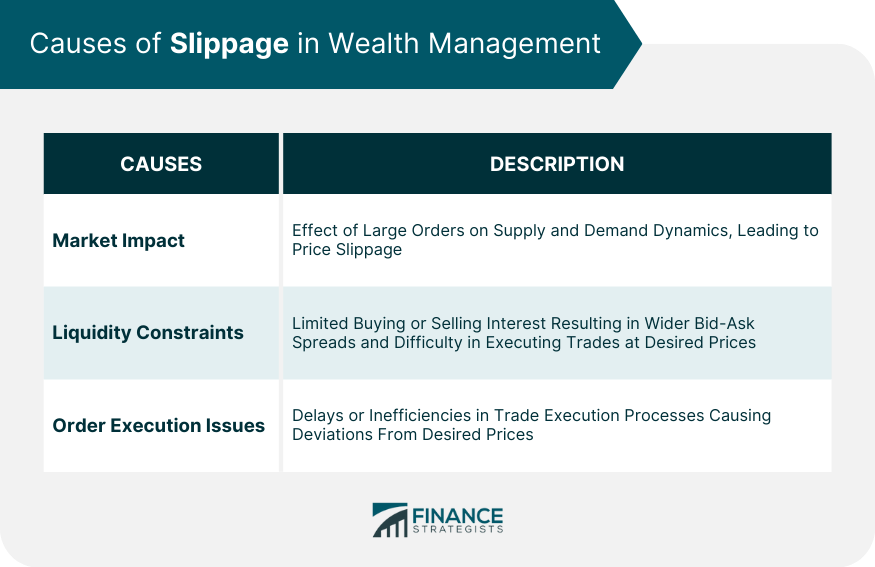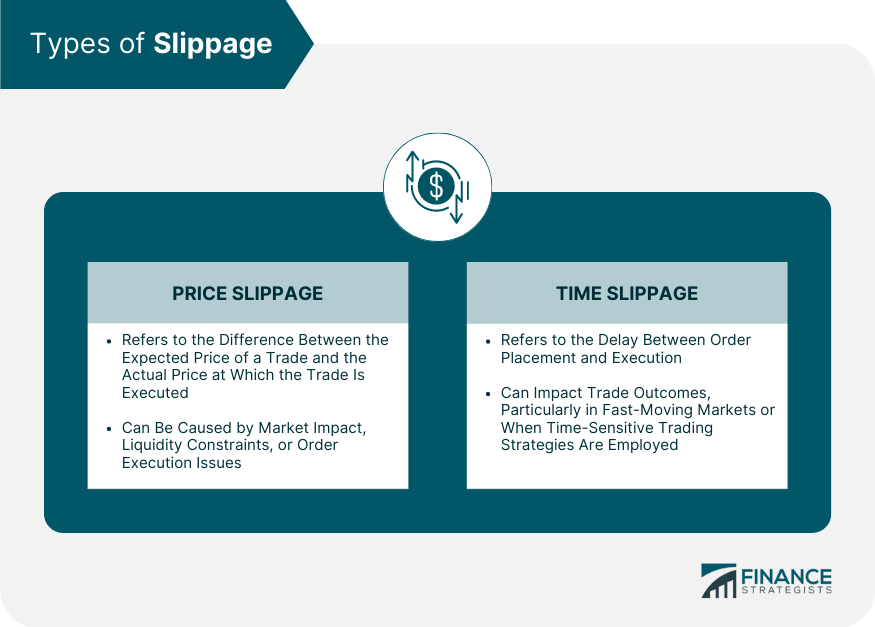Slippage is a term used in financial markets to describe the difference between the expected price of a trade and the actual price at which the trade is executed. It refers to the inability to execute a trade at the desired price due to various factors, resulting in a deviation from the intended execution price. Slippage can occur in both buying and selling transactions and is a common phenomenon in fast-paced and volatile markets. By grasping the concept of slippage, investors and financial professionals can implement strategies to mitigate its impact and enhance the effectiveness of their trading activities. Slippage plays a significant role in wealth management as it has implications for investment returns, portfolio performance, and overall investor success. Inaccurate trade executions due to slippage can lead to financial losses and reduced portfolio performance. By recognizing the importance of slippage, investors can focus on implementing strategies and best practices to mitigate its impact and optimize trade execution. Additionally, slippage is closely tied to market liquidity and efficiency. It reflects the challenges investors face when executing trades, particularly in situations where there is a significant difference between the supply and demand for a particular security. Monitoring slippage can provide valuable insights into market dynamics and investor behavior, helping investors make more informed decisions and adjust their trading strategies accordingly. Market impact refers to the effect of a large order on the supply and demand dynamics of a security. When a substantial buy or sell order is executed, it can influence the price of the security, causing slippage. Market impact is more pronounced in illiquid securities or during periods of high volatility, where even relatively small trades can lead to significant price movements. Investors need to consider the potential market impact of their trades and adjust their execution strategies accordingly to minimize slippage. This may involve breaking up large orders into smaller ones, utilizing algorithms designed to minimize market impact, or executing trades during periods of higher liquidity. Liquidity constraints can contribute to slippage, particularly in situations where there is limited buying or selling interest for a security. Low liquidity can result in wider bid-ask spreads, making it more challenging to execute trades at desired prices. Slippage due to liquidity constraints is more prevalent in thinly traded stocks or in markets with low trading volumes. Investors should be aware of the liquidity profile of the securities they trade and take appropriate measures to mitigate slippage. This may involve focusing on more liquid assets, utilizing limit orders to control the execution price, or adjusting trading volumes to match the available liquidity. Order execution issues, such as delays or inefficiencies in trade execution processes, can also contribute to slippage. Slow order routing, system glitches, or technological limitations can result in delays between order placement and execution, causing the executed price to deviate from the desired price. To minimize slippage due to order execution issues, investors can utilize advanced trading platforms, work with reliable brokers or execution venues, and continuously monitor trade execution processes for any potential inefficiencies. Price slippage refers to the difference between the expected price of a trade and the actual price at which the trade is executed. It occurs when the executed price deviates from the desired price, resulting in financial losses or reduced profitability. Price slippage can be caused by market impact, liquidity constraints, or order execution issues. It can have a significant impact on trade outcomes and portfolio performance. Managing price slippage involves implementing effective trade execution strategies, such as utilizing limit orders, breaking up large orders, or leveraging advanced trading technologies to minimize the deviation between expected and executed prices. Time slippage, also known as delay slippage, refers to the delay between order placement and execution. It occurs when there is a lag between the intended timing of the trade and the actual execution. Time slippage can be caused by order processing delays, system latencies, or other operational inefficiencies. Time slippage can impact trade outcomes, particularly in fast-moving markets or when time-sensitive trading strategies are employed. To mitigate time slippage, investors can employ robust trade execution systems, work with efficient brokers or execution venues, and utilize technologies that enable faster and more accurate order processing. One of the significant consequences of slippage is the potential for financial losses. When trades are executed at prices different from the expected prices, investors may experience immediate financial losses. These losses can erode investment returns, negatively impact portfolio performance, and hinder overall wealth accumulation. Mitigating slippage is essential for investors to minimize financial losses. By implementing effective trade execution strategies, conducting thorough pre-trade analysis, and utilizing advanced trading technologies, investors can reduce the likelihood and magnitude of slippage-related losses. Slippage can also result in reduced portfolio performance. When trades are executed at prices less favorable than expected, it can impact the overall performance of the portfolio. Even small deviations between expected and executed prices can accumulate over time, resulting in a noticeable impact on investment returns. To enhance portfolio performance, investors should monitor and manage slippage proactively. By focusing on pre-trade analysis, employing efficient execution techniques, and continually assessing trade execution processes, investors can optimize portfolio performance and minimize the negative effects of slippage. Slippage can have a psychological impact on investors, particularly if it occurs frequently or results in significant financial losses. Substantial slippage can erode investor confidence, leading to hesitation in executing trades or a loss of trust in trading strategies. To maintain investor confidence, it is crucial to actively address and mitigate slippage. By implementing robust risk management practices, providing transparency in trade execution processes, and communicating effectively with investors, wealth managers can instill confidence and foster long-term relationships based on trust and successful outcomes. Thorough pre-trade analysis and planning are essential to mitigate slippage. Investors should carefully assess market conditions, liquidity profiles, and potential execution risks before placing trades. By conducting comprehensive analysis, investors can anticipate slippage factors and make informed decisions regarding trade size, execution timing, and order types. Pre-trade analysis should also involve setting realistic expectations regarding execution prices and assessing the potential impact of market conditions on trade outcomes. By aligning expectations with market realities, investors can reduce the likelihood of significant slippage. Implementation shortfall is the difference between the benchmark price and the actual execution price of a trade. Minimizing implementation shortfall is an effective strategy to mitigate slippage. This can be achieved by utilizing advanced execution algorithms, which aim to minimize market impact and optimize trade execution efficiency. Investors can also consider employing smart order routing techniques, which direct trades to the most favorable execution venues based on factors such as liquidity, price, and order size. By leveraging technology and smart execution strategies, investors can minimize slippage and improve trade execution outcomes. Implementing effective order execution techniques is crucial for slippage mitigation. This includes using limit orders to control the execution price, utilizing stop orders to trigger trades at specific price levels, and considering market-on-close or market-on-open orders to align execution with specific market periods. Additionally, investors should monitor order execution processes and work with reliable brokers or execution venues that prioritize efficient and accurate trade execution. Regularly evaluating execution quality and making adjustments as needed can further enhance slippage mitigation efforts. Monitoring and measuring slippage require the establishment of performance benchmarks. These benchmarks serve as reference points to evaluate trade execution outcomes and quantify the deviation from expected prices. By comparing actual trade results to performance benchmarks, investors can assess the impact of slippage on their portfolios and identify areas for improvement. Performance benchmarks can be based on factors such as market indices, sector-specific indicators, or customized benchmarks tailored to an investor's specific investment strategy. Regularly tracking and analyzing performance against benchmarks enables investors to identify trends, evaluate execution quality, and make informed adjustments to their trading practices. Various slippage analysis tools are available to help investors measure and analyze slippage. These tools provide insights into execution quality, performance metrics, and potential areas for slippage improvement. Slippage analysis tools can generate detailed reports, offer visualization of trade outcomes, and provide valuable data to support decision-making. Investors and wealth managers can leverage slippage analysis tools to identify patterns, assess the impact of slippage on trade execution, and implement targeted strategies for slippage mitigation. By utilizing these tools, investors can gain a deeper understanding of their trading practices and optimize execution outcomes. Slippage is the deviation between the expected and actual execution prices of a trade. It is an important concept in wealth management as it directly impacts trade execution, portfolio performance, and overall investor success. Slippage can be caused by various factors, including market impact, liquidity constraints, and order execution issues. Implementing effective strategies to mitigate slippage is crucial for investor success. Pre-trade analysis and planning, including assessing market conditions and execution risks, is essential in setting realistic expectations and optimizing trade execution. The importance of slippage mitigation lies in its impact on investor outcomes. Slippage can lead to financial losses, reduced portfolio performance, and a loss of investor confidence. By actively managing slippage and implementing strategies to minimize its effects, investors can enhance their trading outcomes, protect their investment returns, and maintain the trust and confidence of their clients.What Is Slippage?
Importance of Slippage in Wealth Management
Causes of Slippage
Market Impact
Liquidity Constraints
Order Execution Issues

Types of Slippage
Price Slippage
Time Slippage

Consequences of Slippage
Financial Losses
Reduced Portfolio Performance
Impact on Investor Confidence
Strategies to Mitigate Slippage
Pre-trade Analysis and Planning
Implementation Shortfall Minimization
Effective Order Execution Techniques
Monitoring and Measurement of Slippage
Performance Benchmarks
Slippage Analysis Tools
Bottom Line
Slippage FAQs
Slippage refers to the difference between the expected price of a trade and the actual price at which the trade is executed. It occurs due to market impact, liquidity constraints, or order execution issues.
Slippage directly impacts trade execution, portfolio performance, and investor success. Understanding and mitigating slippage are crucial for optimizing investment outcomes and minimizing financial losses.
Slippage can be caused by market impact, liquidity constraints, and order execution issues. Understanding these causes helps investors identify potential slippage risks and develop strategies to mitigate its impact.
Strategies to mitigate slippage include pre-trade analysis and planning, implementation shortfall minimization, and effective order execution techniques. These strategies help optimize trade execution and reduce slippage-related losses.
Slippage can be monitored and measured by establishing performance benchmarks and utilizing slippage analysis tools. These tools provide insights into execution quality, performance metrics, and areas for slippage improvement.
True Tamplin is a published author, public speaker, CEO of UpDigital, and founder of Finance Strategists.
True is a Certified Educator in Personal Finance (CEPF®), author of The Handy Financial Ratios Guide, a member of the Society for Advancing Business Editing and Writing, contributes to his financial education site, Finance Strategists, and has spoken to various financial communities such as the CFA Institute, as well as university students like his Alma mater, Biola University, where he received a bachelor of science in business and data analytics.
To learn more about True, visit his personal website or view his author profiles on Amazon, Nasdaq and Forbes.











